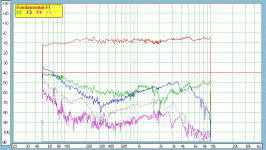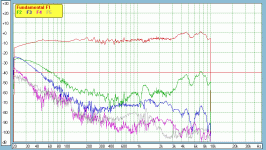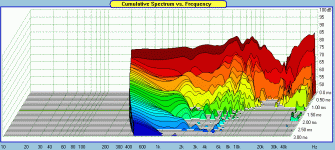Zvuchniak, its like saying hey, Tannoy used 15" midbas in their 2way dual concentric speakers...therefore 15" midrange must be good.
My AINOgradietn project http://www.diyaudio.com/forums/multi-way/231353-aino-gradient-collaborative-speaker-project.html
I had a struggle with midrange directivity... changed to Neo8 mid in december 2013.
adason, here is a 12" mid http://www.danielhertz.com/index.php/products-2/m1

I had a struggle with midrange directivity... changed to Neo8 mid in december 2013.
adason, here is a 12" mid http://www.danielhertz.com/index.php/products-2/m1

Last edited:
I would like to choose chart 1&2 because the frequency reponse of upper mid at 0.0ms is quite flat. That means, it doesn't need additional passive components, such as CR or LCR filters which makes the sound terbid, to flatten the crossover range.
Your comment, "Could that 6.5" driver possibly have lower distortion and a better damped cone than a 4" or 5" one? Could it possibly sound better? Obviously, there are many designers who think the answers to those questions is yes." is quite impressive.
Is this comment about the "midrange" or "mid-bass range" of the driver ?
Well, 1 & 2 were for a 4" driver, 3 & 4 for a 6.5" and 4 & 5 for a 5" driver. Personally, between the 3 of them just based on the graphs re-posted again below, I would probably choose the the larger driver because the offending 3rd harmonic distortion levels are lower right across the whole mid passband especially in the critical midrange region (about 15dB lower by 2kHz) and the cone resonances look just a touch cleaner as well. And it is still very flat right up to about 3Khz. And I know of 1 designer who has used that driver with a LP xo using just 2 components with well regarded results - The Tributes.
Attachments
Last edited:
Please read these reviews of two níce 3-ways with small mids. Midrange clarity and purity and imaging is praised. Distortion is not a problem.
Magico S5 Magico S5 Loudspeaker | Stereophile.com
Sorry, I just have to correct you on this one. That Magico uses a 6" mid. Magico Product | S5
Geddes Harper is primarily 2way speaker...you are mixing stuff up Zvuchniak.
But of course it isn't two way loudspeaker. If you think a little i'm not mixing up anything. None of the Gedlee speakers are primarilly two way. Every one of them needs dedicated subs for under 150Hz to 30Hz.
I'd like to se anyone who uses Harper as is cause that is not a complete loudspeaker without at least 3 subs as Dr Geddes suggests.
Zvuchniak, its like saying hey, Tannoy used 15" midbas in their 2way dual concentric speakers...therefore 15" midrange must be good.
First of all Tannoy does not have good midband. Like it or not, compare it to a good three way loudspeaker in A/B test and you'll see.
Tannoy used 15" coaxial loudspeakers that have no need for extra bass unit to get down to 30-40Hz or so, so that is two way loudspeaker. In monitor gold, HPD385 has xover point at 1200Hz. Can you imagine off axis of a 15" loudspeaker unit that goes that high? soundwise it lacks deffinition in midband.
Last edited:
My AINOgradietn project http://www.diyaudio.com/forums/multi-way/231353-aino-gradient-collaborative-speaker-project.html
I had a struggle with midrange directivity... changed to Neo8 mid in december 2013.
I was convinced that i saw that thread few years ago but now i see that you've started it in march 2013.
Thanks Juha 🙂
Last edited:
Tannoy used 15" coaxial loudspeakers that have no need for extra bass unit to get down to 30-40Hz or so, so that is two way loudspeaker. In monitor gold, HPD385 has xover point at 1200Hz. Can you imagine off axis of a 15" loudspeaker unit that goes that high? soundwise it lacks deffinition in midband.
The Tannoys which cross over at 1200Hz are their 12" drivers.
It happens to be the exact frequency at which a 12" drivers dispersion narrows to 90deg and matches the tweeters dispersion.
Pretty much textbook really...
The Tannoys which cross over at 1200Hz are their 12" drivers.
It happens to be the exact frequency at which a 12" drivers dispersion narrows to 90deg and matches the tweeters dispersion.
Pretty much textbook really...
That is not quite true. Maybe they intended to do so but Troels Gravesen did measure them and came up with this: TannoyMG15
Last edited:
Except that the Tannoy crossover is not a simple straight 12dB one.
There is quite some overlap and the lp series inductor has a xover point of 1060Hz while its associated cap starts at 620Hz.
Basically a 6dB crossover at 1060Hz which steepens to 12dB below 620.
One mistake Troels made during his measurements is measuring on axis while Tannoy themselves measure (and recommend listening) at least 15deg off axis.
In a short email conversation I once had with him he agreed that most of the audible and measured problems largely disappear when following Tannoys recommendations.
Another mistake is believing that the Beatles used Tannoys at Abbey Road.
When they recorded there Abbey Road was using Altecs.
There is quite some overlap and the lp series inductor has a xover point of 1060Hz while its associated cap starts at 620Hz.
Basically a 6dB crossover at 1060Hz which steepens to 12dB below 620.
One mistake Troels made during his measurements is measuring on axis while Tannoy themselves measure (and recommend listening) at least 15deg off axis.
In a short email conversation I once had with him he agreed that most of the audible and measured problems largely disappear when following Tannoys recommendations.
Another mistake is believing that the Beatles used Tannoys at Abbey Road.
When they recorded there Abbey Road was using Altecs.
Because of that overlap it is absolutely impossible to determine the actual xover point so it is more of an arbitrary thing. The real problem in my oppinion is letting 15" bass to interfere that high in midrange.
But that is moving us away from the thread topic 🙂
But that is moving us away from the thread topic 🙂
Last edited:
Two-way, three-way, four-way, a 6.5" driver is a popular size and it covers a wide band of the audio spectrum with verve.
TEST: Hightech 2-Wege-Kompaktlautsprecher Dali Epicon 2 – dänische Raffinesse | AREA DVD – Tests & News fürs Heimkino, Fernseher, LCD-TVs, Ultra HD, Surround, AV-Receiver, Lautsprecher, Blu-ray Disc-Player, Smartphones, Tablets, Kino-Fi
__________
* For the subterranean bass integration; two separate subs with DSP and DRC aids (plus acoustical room treatment of course).
** Super tweeter for SACD (50kHz)? ...Crossover-less.
TEST: Hightech 2-Wege-Kompaktlautsprecher Dali Epicon 2 – dänische Raffinesse | AREA DVD – Tests & News fürs Heimkino, Fernseher, LCD-TVs, Ultra HD, Surround, AV-Receiver, Lautsprecher, Blu-ray Disc-Player, Smartphones, Tablets, Kino-Fi
__________
* For the subterranean bass integration; two separate subs with DSP and DRC aids (plus acoustical room treatment of course).
** Super tweeter for SACD (50kHz)? ...Crossover-less.
Zvuchniak, I know exactly what you are saying, especially about Geddes speakers, I am familiar with his multiple subs approach, I always liked that. But you have to acknowledge that there is a big difference between dedicated 3way speaker all in one box (see numerous examples on Troels Gravesen site, Curt's speaker design works, Humble Homemade Hifi, RJaudio...an many others) or satellite and subwoofer.
All in one box 3way has completely different design criteria than 2way satellite with subwoofer/s...if you do not understand this than we are on completely different level and talking about different things.
I though this thread is about 3way in one box. If not, sorry, I was wrong. (because I did built 2way satelites with 6" fullrange and ribbon supported by sub, but that is a different story). I am out...
All in one box 3way has completely different design criteria than 2way satellite with subwoofer/s...if you do not understand this than we are on completely different level and talking about different things.
I though this thread is about 3way in one box. If not, sorry, I was wrong. (because I did built 2way satelites with 6" fullrange and ribbon supported by sub, but that is a different story). I am out...
I happen to have some speakers with 12" bass, 6" midrange and 1" tweeter on 500Hz and 3.5kHz crossover:
Celestion Ditton 44.
What I can tell you is they do sound a bit rough in the midrange. But they do go incredibly loud without undue distortion, and the good dispersion is what you would expect from a three way. That midrange can really deliver some SPL.
Perhaps it is a slightly unbalanced ratio of drivers. 12" bass and 1" tweeter seems to say 4" midrange to me. Something to do with balance, because 3.5kHz crossover is a bit high for a 6" midrange cone that breaks up at 5kHz. You can hear the rough breakup. 🙂
An externally hosted image should be here but it was not working when we last tested it.
Celestion Ditton 44.
What I can tell you is they do sound a bit rough in the midrange. But they do go incredibly loud without undue distortion, and the good dispersion is what you would expect from a three way. That midrange can really deliver some SPL.
Perhaps it is a slightly unbalanced ratio of drivers. 12" bass and 1" tweeter seems to say 4" midrange to me. Something to do with balance, because 3.5kHz crossover is a bit high for a 6" midrange cone that breaks up at 5kHz. You can hear the rough breakup. 🙂
"Why 6.5" as a mid?" I'd say, why not?
Then it's becoming "Why 8" as mid?" Again, I'd say, why not?
Also, "Why 15" in a 2-way?". Same, why not?
I had tried a 12" guitar driver as the mid up to about 3kHz in a OB 3-way. TBH, I like it very much. It's more dynamic and lively than the later 8" I used shortly. I had enjoyed a lot of music back then.
Yes, the off-axis reponse is worse on the larger one. So what? Nothing is perfect.
Cone breakup? Yeah, unavoidable in almost all cone drivers. So I turned to DML and found it's very interesting.
Then it's becoming "Why 8" as mid?" Again, I'd say, why not?
Also, "Why 15" in a 2-way?". Same, why not?
I had tried a 12" guitar driver as the mid up to about 3kHz in a OB 3-way. TBH, I like it very much. It's more dynamic and lively than the later 8" I used shortly. I had enjoyed a lot of music back then.
Yes, the off-axis reponse is worse on the larger one. So what? Nothing is perfect.
Cone breakup? Yeah, unavoidable in almost all cone drivers. So I turned to DML and found it's very interesting.
If cringe-worthy cone breakup is a problem then just get a driver that has a phase plug and not a dustcap. I have a pair of AE TD6M and while they have some issues the high end is not one of them, as John says they are listenable full range without problems.
And apart from that I agree with why not 6.5"? As long as you have another driver that in the crossover region has matching dispersion you can use any diameter you want.
And bigger is more sensitive, so if you can get away with a bigger mid without any issues it is nice.
And apart from that I agree with why not 6.5"? As long as you have another driver that in the crossover region has matching dispersion you can use any diameter you want.
And bigger is more sensitive, so if you can get away with a bigger mid without any issues it is nice.
Last edited:
I like splitting the mid-range duties between two drivers myself. Currently using a 9 1/2" cone ( aka 12" low mid .. down to 100hz) with a 4" cone (upper mid .. 3.2k to tweeter) in naked form (xo @500hz between them). Getting the voicing right is key ... and they sound very good together. Voices have weight (effortless) due to the larger cone ... instruments such as the piano sound pretty real in the lower register too. The smaller cone adds a little sweetness to the upper register without stressing the tweeter.
The phase plug will delete dust cap breakup, not that of the cone. There remains the surround's sound, and frame/magnet structure resonance, not to mention what the enclosure contributes. Maybe I like larger mids since they disperse the various problem frequencies more broadly than the theoretically superior 4-5 inch drivers. Moreover, they may do no such thing; JMO/YMMV.
The phase plug will delete dust cap breakup, not that of the cone. There remains the surround's sound, and frame/magnet structure resonance, not to mention what the enclosure contributes. Maybe I like larger mids since they disperse the various problem frequencies more broadly than the theoretically superior 4-5 inch drivers. Moreover, they may do no such thing; JMO/YMMV.
True, but assuming you have a soft and not a hard cone then cone breakup is kinda nice. The dispersion slowly narrows in a predictable and consistent way that is easy to match with say a waveguided tweeter.
EDIT: Though if you have a hard cone then sure breakups a problem, but it is related to cone diameter and is only an issue if you want to push the driver higher up than it was designed to.
Last edited:
Is there a more likeable woofer than this SEAS jobbie? No dustcap problems to worry about.
H1659-08 U22REX/P-SL
Clearly Siegfried Linkwitz doesn't think so. 🙂
H1659-08 U22REX/P-SL
Clearly Siegfried Linkwitz doesn't think so. 🙂
- Status
- Not open for further replies.
- Home
- Loudspeakers
- Multi-Way
- Why 6.5 inches as a midrange ?



